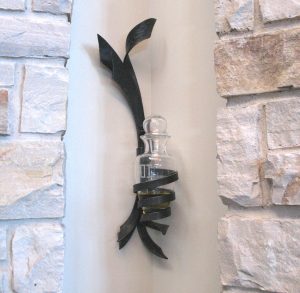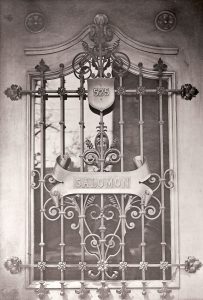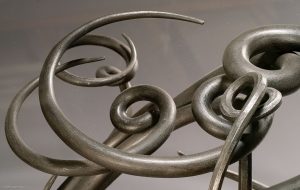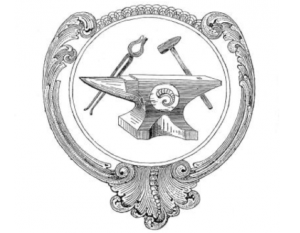New Horizons in Metal
After forging decorative and architectural ironwork for over 30 years, there seems to be no end to design possibilities in sight. The thrill of discovery, of new forms, of yet untried motifs, has me returning to the drawing board, and consequently to the fire with anticipation.
This is the stuff that keeps the engine stoked, and also keeps the projects fresh. The virtual smorgasbord of details, styles, and processes, keeps my mind and hands busy.
Over the years, much of my work has been of classic designs and motifs. While I still enjoy these aspects of designs and architectural elements, there is a need to break-out into different ideas and more sculptural forms, as in the piece below.
Years ago, I recognized that as the recent body of blacksmiths matures, the direction of their design interests varies. Some have vastly improved upon a specific period of work. Others have dabbled in many aspects of classic design. The progression for some has gone from that of fine craftsmen to artist. Some have created new forms that are defined as unique to their art form……one often knows that it is their work simply by looking at it. These are the individuals whose careers were launched in the 60’s, 70’s, and 80’s.
Names such as Albert Paley, John Medwedeff, and Tom Joyce (USA), Simon Benetton (Italy), Alfred Habermann (Czech Republic) and Anthony Robinson (England) are examples of individuals whose works and styles are uniquely theirs. It wasn’t long ago that I failed to understand or appreciate the work of these individuals. My focus was on the great masters that came before us, whose works reflected Gothic, Renaissance, and Baroque styles.
It is interesting to note that while early master smiths such as Cyril Colnik and Samuel Yellin are very respected in our ranks, their work is not often identifiable as their own simply by looking at it, as their works typically borrow from classic design, blurring the identity of the maker.
You might have gazed upon a fine gate of classic forms, observed fine details, and exquisite workmanship. Then you might have pondered, “Is it of Colnik?” if you were in the Milwaukee area, or “Is it of Yellin?” if you were in the eastern states. Usually you cannot be certain without some form of provenance.
Who made this fine grille below? (Answer at end of this post. Hint….it wasn’t “Salomon”.)
Indeed the works of Colnik and Yellin speak of fine workmanship, details, and composition. Personally I will always look towards their work as a benchmark for quality and execution.
And…… I shall always be intrigued with these and other past masters, of classic design, and of period work. There is still so much to learn.
In the past few years, I have also become intrigued, inspired, and increasingly more appreciative of the more sculptural aspects of some of today’s contemporary smiths and metalworkers. My new appreciation has caused me to experiment more with the plasticity of metal, as well as with different processes.
You may be wondering, “What is the point of this dialogue?” I am merely pointing out my own impressions of the works of others, and who might be remembered for what. This is not to try to define “what is art and what is craft.” I believe some will be remembered for being a fine master of all styles that preceded them. Some may be remembered for a few stand out pieces. Others will be chronicled for creating new forms.
Another aspect of this discussion is how my own ideas on design have been changed and influenced. I feel my background in classic forms are the groundwork for what is to come, whether continuing in more of the same, or expressing new ideas in iron. The works of others, past and present, have and do play a role in my development of ideas.
With these thoughts in mind, I present to you one of my recent works, a glassed topped table, measuring 18″ x 24″.
It is the flowing lines, and the composition of the smooth bars as they relate to each other that I enjoy in this piece. The bars begin in a gentle curve, then finish in a sudden swirling flurry. The octagonal and twisted element adds some contrast and flavor to the piece.
Below is a detail shot of the table.
To continue in this particular phase of my work, I am currently creating a complimentary plant stand.
These and other pieces will be displayed next year at a personal showing at “Villa Terrace Decorative Arts Museum”, April through June 2010.
Table images were taken by photographer George Lottermoser.
…..Dan Nauman
“Don’t let making a living interfere with making a life.” …..John Wooden, UCLA Basketball Coach
Who made the fine grille?
Answer: “Cyril Colnik (1871-1958)”






Has one comment to “New Horizons in Metal”
Laurel Turner - October 14, 2009
I can’t wait to see your show at the Villa, your modern work is breathtaking.